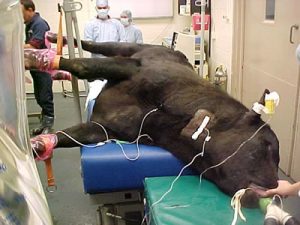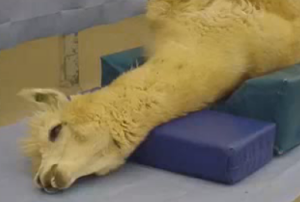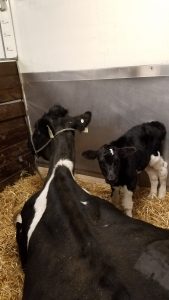Food Animal Drugs
Food Animal General Anesthesia Protocols and Procedures
Recumbent procedures are not common in adult cattle but do happen (sometimes when a standing procedure becomes a recumbent procedure due to cow factors) and are the norm for camelids, small ruminants, and pigs. Both standing and recumbent procedures are performed in calves, depending on the age and size of the calf, the duration of the procedure, etc.
Field anesthesia is typically safe for up to 60 minutes. After that time, complications are more likely.
As with other species, anesthesia involves
- sedation – xylazine (occasionally detomidine, dexmedetomidine, romifidine or acepromazine)
- optional additional sedatives or analgesics -butorphanol or acepromazine (given with sedatives) AND/OR diazepam or midazolam (given at induction)
- induction – ketamine, telazol, guaifenesin (GG)
- maintenance – repeated doses of sedatives and induction agents or infusion of drugs and drug combinations
Often sedation and induction are combined; ruminants do not have the same eventful excitement phase as do horses.
Ruminants, camelids and pigs are generally not intubated or maintained on inhalant anesthetic agents except in specialty or referral settings. Intubation is tricky so many are kept light (good respirations) and pain is controlled with narcotics and local blocks.

Ruminants do like to regurgitate and drool during anesthesia. Atropine only makes the drool thicker so we don’t use it. It is important to ensure that drool and rumen contents drain out. The nose should be lower than the poll (top of the head), often with the neck elevated with a pad to ensure everything runs downhill and out, not back into the airways.
Ruminants also like to bloat when sedated. This impairs respiration and cardiac output. Not only does the rumen push on the chest but it compresses diaphragmatic vessels and impairs return of blood to the heart. To minimize rumen fill, adult large ruminants are held off feed for ~ 24 hours when possible (small ruminants need ~18 hours). Many references recommend removal of water. This may not be necessary unless animals are drinking excessively.
Monitoring is typically through vital signs (pulse quality and rate, respiratory quality and rate, ocular reflexes and positioning).

Pulse oximeters are portable and easy to use. Doppler blood pressure monitoring is useful particularly in smaller patients.
Smaller ruminants and pot bellied pigs can be put on surgery tables and managed like big dogs. Or they can be managed on a padded floor! Knee pads are useful for the surgeon, too, in this situation.
Common induction and maintenance agents
Ketamine combinations
Ketamine is a dissociative anesthetic agent used to induce recumbency after sedation when given at higher doses.
It is commonly combined with other drugs (xylazine, diazepam or midazolam, guaifenesin) to prolong the anesthetic duration and to enhance relaxation.
Ketamine is a relatively safe drug with minimal cardiovascular or respiratory depressant effects. “It is hard to kill with ketamine.” Unlike in horses, there is minimal excitement phase in ruminants. Both the sedative and induction agents can be combined in the same syringe (eg ketamine/diazepam or xylazine/ketamine) and given at the same time.
Protocols typically combine sedation and induction drugs:
Cattle:
- xylazine 0.05-0.1 mg/kg and ketamine 2 mg/kg iv (double for im administration)
- diazepam/midazolam 0.1 mg/kg and ketamine 2 mg/kg iv
- recumbent iv ketamine stun: xylazine 0.05 mg/kg + butorphanol 0.05- 0.1 mg/kg + ketamine 0.5 -1 mg/kg
- for a 500-600kg cow, this 20/25/250 mg of B/X/K
- infusion: 1-1.5g ketamine added to 1L electrolyte solution along with 50 mg xylazine or with 25-50 mg benzodiazepines administered as iv drip
- for free ranging cattle (wild)- xylazine 0.3-0.5 mg/kg, ketamine 0.7-1 mg/kg, telazol 0.7-1 mg/kg. Administer im. Works for nonpainful procedures.
Llamas: xylazine 0.4-0.5 mg/kg and ketamine 4-6 mg/kg im
Alpacas: xylazine 0.6-0.8 mg/kg and ketamine 6-8 mg/kg im
Swine: xylazine 2 mg/kg and ketamine 20 mg/kg im
Telazol and Telazol combinations
Schedule III
Telazol is a combination of tiletamine (dissociative agent like ketamine) and zolazepam (benzodiazepine like diazepam). It lasts longer than ketamine/diazepam but is more expensive.
The drug needs to be reconstituted prior to use and then has a limited shelf life.
Telazol-xylazine: reconstitute telazol with 500 mg xylazine instead of the standard diluent. Give 3-5ml to large bulls im.
TKX: reconstitute telazol with 100-150mg xylazine and add ketamine to total volume of 5 ml. Useful with pole syringe administration or dart gun for wild or aggressive cattle (5ml/600-800 kg). [Telazol 500/xylazine 100/ketamine 400mg]
Other example protocols
cattle: 0.1 mg/kg xylazine + 1-2 mg/kg telazol iv
sheep: 2-4 mg/kg telazol iv
llama: 0.25 mg/kg xylazine + 2 mg/kg telazol im
swine: 2.2 mg/kg xylazine + 4.4 mg/kg telazol im
GG and Bovine Triple Drip
Triple drip is a combination of xylazine, ketamine and guaifenesin (GG) used to induce and/or maintain anesthesia.
Xylazine (50 mg), ketamine (1000 mg or 1 g), in a liter of 5% guaifenesin (50mg/ml), given at 1ml/lb/hr.
Guaifenesin is a muscle relaxant that helps counteract the rigidity associated with ketamine. The combination must be compounded and can be explosive if done incorrectly.
Triple drip can be used for induction (0.5-2 ml/kg) but has a slightly delayed effect so overdosing is a risk. However, the gradual induction minimizes the apnea risk.
Maintenance with triple drip is relatively easy in cattle. The anesthetic plane is rapidly adjusted by changing the drip rate (0.5-2 ml/kg/hr).
Side effects : Very irritating perivascularly. Use a catheter. Overdoses of GG can lead to increased muscle tone, making the animal appear too light vs too deep. Ruminants are sensitive to xylazine and xylazine may cause pulmonary edema, especially in sheep.
Double drip
Double drip infusion avoids the risk of xylazine for ruminant anesthesia maintenance.
Ketamine (1mg/ml or 1g/L) is added to 5% Guaifenesin.
Butorphanol or morphine should be added for analgesia. Butorphanol (0.05-0.1 mg/kg IV or IM in smaller ruminants, 0.02-0.05 mg/kg IV or IM in larger ruminants) or morphine (0.05-0.1 mg/kg IV or IM).
Induction with double drip takes a lot of drug (1.7-2.2 ml/kg); we typically use other drugs to induce. Maintenance is to effect; Abrahamsen recommends starting at approximately 2.6 mL/kg/hour (Abrahamsen, 2013)
Other IV infusions
Midazolam drip recipe: 5ml (25 mg) midazolam + 20 ml (2 g) ketamine +5 ml (100 mg) 20mg/ml xylazine in 1 liter bag fluids.
Xylazine/ketamine drip recipe: 50 mg xylazine and 1.0 to 1.5 g ketamine added to 1 L electrolyte solution
Muscle relaxation should be satisfactory if an adequate dose of xylazine is used at induction, or it can be improved by administering 25 to 50 mg of midazolam or diazepam intravenously as a bolus or by increasing the infusion rate of xylazine and ketamine. Approximately 1 drop/3-5 secs for each 100# BW
Llama lullaby
To one bottle of ketamine (10 ml of 100 mg/ml) add 1 ml of 100 mg/ml xylazine and 1 ml of 10 mg/ml butorphanol. Given 1 ml /50 lbs BW IM for 40-50 min procedures.
More specific doses of ketamine stuns for camelids:
- xylazine 0.22-0.55 mg/kg + ketamine 0.22-0.55 mg/kg + butorphanol 0.08-0.11 mg/kg im
Alpha 2 combinations (recumbent sedation)
Medetomidine
- Medetomidine alone (0.03 mg/kg im) leads to lateral recumbency for 60-70 minutes in calves
- Medetomidine can be administered via dart gun at 0.04 mg/kg to immobilize free ranging cattle.
- Medetomidine (0.06 mg/kg im) and telazol (1.2 mg/kg im) produced immobilization and analgesia for minor procedures for up to 60 minutes
Xylazine + diazepam
Cattle -Xylazine (0.2 mg/kg) and diazepam (0.1 mg/kg) leads to recumbency in cattle up to 30 minutes
Calves older than 2 weeks: IV xylazine (0.05 mg/kg) and diazepam (0.2 mg/kg) leads to recumbency. Add morphine (0.5 mg/kg IM) for intense analgesia for 3-4 hours.
Calves up to 1 week: diazepam (0.2 mg/kg IV) and butorphanol (0.1 mg/kg IV)
Please double check all doses in these protocols before using. Withholding requirements do apply to these drugs! Nothing is approved so AMDUCA rules also apply.
Overview
- Butorphanol and/or the benzodiazepines can be added to smooth and prolong anesthesia.
- Ketamine is safe and effective at creating recumbency.
- Acepromazine can be used for healthy agitated animals and can help smooth their recovery.
- Guaifenesin (GG )is combined with xylazine and ketamine to create ”triple drip”, an infusion that works very well in cattle.
- Leave the xylazine out to make it even safer as “double drip”.
- If GG isn’t available, we usually give repeated half doses of the sedative and ketamine to increase duration of anesthesia.
- The benzodiazepines, acepromazine and narcotics tend to have long enough half lives that redosing isn’t needed.
- You can create an infusion of xylazine and ketamine as well.
Recovery

Our ruminant patients are much easier to recover safely than the horses. They like to lie still and can be left to their own devices in a stall if warm and dry. Cold patients need to be warmed up to enhance recovery. As long as the patient can swallow and keep themselves in sternal, they do fine. The ruminant will stand up when it is time, rarely before that.
As mentioned above, ruminants do develop rumen stasis under general anesthesia so bloat can be an issue if they are under GA for too long and care needs to be taken to ensure they are sternal during recovery. If they cannot maintain sternal recumbency, the bloat can persist to danger points. Regurgitation is also common so it is important to ensure they will not aspirate any fluid that is regurgitated (sternal recumbency is good for this too).
FAQs/Preventable errors
- Xylazine and lidocaine bottles look similar, so make sure you are administering the correct drug
- Use atipamezole as reversal agent for an alpha-2 ‘accident’
- Any alpha -2 antagonist = IV, give slowly
- When is it safe to use xylazine in calves?
- 4-6wks is the transition between neonatal to pediatric age
- Factors to consider between beef and dairy
- Body condition, weight estimation (use low end of drug range)
- Aggressive bulls
- Alpha -2 (for dilution) + telazol
- Sedation effects on calves during C-sections
- More dependent on time rather than drugs chosen
- The dosages you use for standing procedures shouldn’t affect calf
- Opioids affect the calf. Try to avoid administering butorphanol or morphine within 30min before the calf comes out, can give after c-section
- Drugs can cross the blood brain barrier (for mom), can also cross into the placenta
- Fasting time
- Very hard to ventilate with a rumen full of ingesta or fluid
- Can manage rumen fluid flowing out of mouth – ie suction
- More difficult to improve ventilation issues due to a full rumen
- Can also get tympany
- Hold off water, as well (last 12 hours)
Resources
Small ruminant anesthesia (chapter)
Camelid anesthesia (chapter)
Pig anesthesia (chapter)
Chemical restraint of ruminants- ketamine stun techniques, Abrahamsen circa 2008
Field Sedation and Anesthesia of Ruminants, August 2016, Veterinary Clinics of North America Food Animal Practice 32(3)– has good information on duration of effect of various protocols. There are typos in the article. Correct the doses to xylazine 0.05mg/kg im + butorphanol 0.1mg/kg im + ketamine 0.5 mg/kg im for the ket stun
Guidelines on Anesthesia and Analgesia in Ruminants, UMI, 2018
Large Ruminant Anesthesia, 2012 ACVS
Allweiler FA anesthesia lecture ppt
Plumb’s Veterinary Drug Handbook and app (lots of versions out there in different formats and prices)
Fun hernia repair video – creative use of a wheelbarrow! See on youtube
Substances in this schedule have a potential for abuse less than substances in Schedules I or II and abuse may lead to moderate or low physical dependence or high psychological dependence.
An anesthetic that distorts sensory perceptions and causes feelings of detachment from reality.

